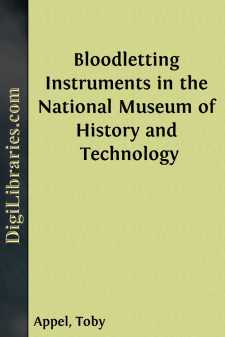Categories
- Antiques & Collectibles 13
- Architecture 36
- Art 48
- Bibles 22
- Biography & Autobiography 813
- Body, Mind & Spirit 142
- Business & Economics 28
- Children's Books 17
- Children's Fiction 14
- Computers 4
- Cooking 94
- Crafts & Hobbies 4
- Drama 346
- Education 46
- Family & Relationships 57
- Fiction 11829
- Games 19
- Gardening 17
- Health & Fitness 34
- History 1377
- House & Home 1
- Humor 147
- Juvenile Fiction 1873
- Juvenile Nonfiction 202
- Language Arts & Disciplines 88
- Law 16
- Literary Collections 686
- Literary Criticism 179
- Mathematics 13
- Medical 41
- Music 40
- Nature 179
- Non-Classifiable 1768
- Performing Arts 7
- Periodicals 1453
- Philosophy 64
- Photography 2
- Poetry 896
- Political Science 203
- Psychology 42
- Reference 154
- Religion 513
- Science 126
- Self-Help 84
- Social Science 81
- Sports & Recreation 34
- Study Aids 3
- Technology & Engineering 59
- Transportation 23
- Travel 463
- True Crime 29
Bloodletting Instruments in the National Museum of History and Technology
by: Toby Appel
Description:
Excerpt
Introduction
Bloodletting, the removal of blood from the body, has been practiced in some form by almost all societies and cultures. At various times, bloodletting was considered part of the medical treatment for nearly every ailment known to man. It was also performed as punishment or as a form of worship to a Superior Power or Being. It still retains therapeutic value today, although only for an extremely limited range of conditions. In early attempts to extract blood from the body, the skin was penetrated in various places with a sharp instrument made of stone, wood, metal, bristle, or any other rigid material. When it was recognized that a vein visible on the surface of the skin as a blue-green stripe contained blood, the vein was incised directly. To facilitate “breathing a vein” and to provide greater safety, more refined and sharper instruments were devised. As theories supporting bloodletting grew more complex, so too did the instruments.
Spontaneous forms of bleeding, including nosebleed, menstruation, and those instances produced by a blow to any part of the body, apparently inspired the earliest human bloodletters. The Egyptians claimed that the hippopotamus rubbed its leg against a sharp reed until it bled to remove excess blood from its body. The Peruvians noted that a bat would take blood from the toe of a sleeping person when the opportunity presented itself. A deer, and goat, would pick a place near its diseased eye for relief. The methods employed by animals increased interest in using artificial methods for letting blood in man.
The devices man has employed to remove blood from the body fall into two major categories: (1) those instruments used for general bloodletting, that is, the opening of an artery, or more commonly a vein, and (2) those instruments used in local bloodletting. Instruments in the first category include lancets, spring lancets, fleams, and phlebotomes. Associated with these are the containers to collect and measure the blood spurting from the patient. In the second category are those instruments associated with leeching and cupping. In both of these methods of local bloodletting, only the capillaries are severed and the blood is drawn from the body by some means of suction, either by a leech or by an air exhausted vessel. Instruments in this category include scarificators, cupping glasses, cupping devices, and many artificial leeches invented to replace the living leech.
Much effort and ingenuity was expanded, especially in the eighteenth and nineteenth centuries, to improve the techniques of bloodletting. In the eighteenth century, delicate mechanical spring lancets and scarificators were invented to replace the simpler thumb lancets and fleams. In the nineteenth century, as surgical supply companies began to advertise and market their wares, many enterprising inventors turned their hand to developing new designs for lancets and scarificators, pumps, fancy cupping sets, rubber cups, and all manner of cupping devices and artificial leeches....


